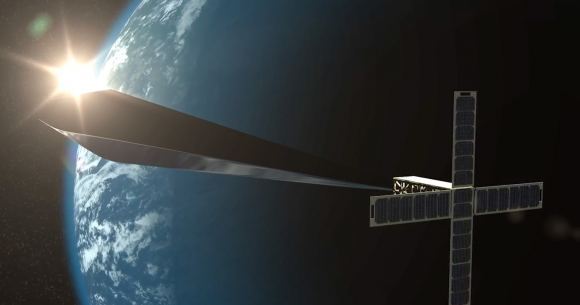
UPDATE – SpaceX has now set a firm date and time for the Spaceflight SSO-A launch from Vandenberg Air Force Base for Monday, December 3nd at 18:31 Universal Time (UT).
A unique smallsat mission promises to be the latest satellite “brighter than a Full Moon!” in the night sky… or not.
The Mission: We’re talking about Orbital Reflector, conceived by Trevor Paglen and fielded by the Nevada Museum of Arts. Dubbed as the “first art exhibit in space,” the $1.3 million dollar project seeks to put a smallsat payload with a deployable reflector in low Earth orbit. The mission is just one of a multitude of satellites aboard the next SpaceX launch set to liftoff from Vandenberg Air Force Base in California atop a reused Falcon-9 stage 1 booster. And while the 64 small satellite payload isn’t a record—that title still goes to an Indian PSLV rocket, which launched 104 satellites in one shot last year on February 15th, 2017—this will mark the first time a SpaceX Falcon-9 rocket stage 1 booster has been reused, twice.
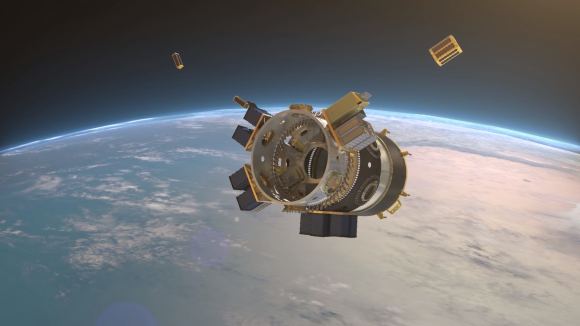
The Launch: The Spaceflight SSO-A smallsat express mission has been an on-again, off-again affair for most of 2018. The launch was set to go this past Monday on November 19th, until SpaceX pushed the date back, citing a need for further pre-flight booster inspections. A new launch date is forthcoming from SpaceX, and probably won’t occur until after U.S. Thanksgiving on November 22nd.
Standing down from Monday’s launch attempt of Spaceflight SSO-A: SmallSat Express to conduct additional pre-flight inspections. Once complete, we will confirm a new launch date.
— SpaceX (@SpaceX) November 17, 2018
The SSO-A (Sun Synchronous Orbit) mission is the first fully dedicated ride-share mission, with 64 spacecraft contributed by 25 international organizations from 17 countries. For an exhaustive who’s who list of the entire manifest, click and explore the Spaceflight SSO-A press kit. Unlike most cubesats, which hitch a ride along with a primary large satellite payload, Spaceflight’s SSO-A launch is exclusively dedicated to small-sat missions.
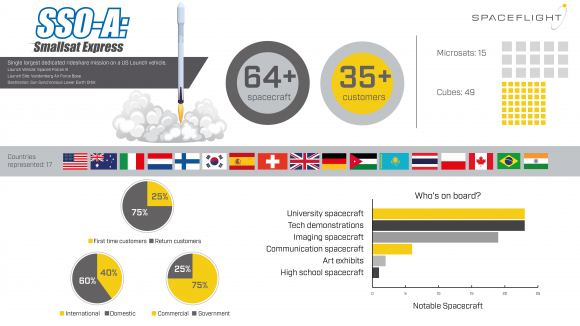
Orbital Reflector is the mission on the roster that most backyard observers and satellite spotters will be watching for.
After it departs its satellite dispenser, Orbital Reflector will deploy an obelisk-shaped, lightweight reflective balloon 30 meters long by 1.4 meters wide.
A Brief History of Putting Shiny Things in Orbit
Ironically, one of the first reflective satellites was also the best and brightest: The U.S. put Echo-1 in low Earth Orbit on August 12th, 1960 a large 30.5 meter (interestingly, about the same length as Orbital Reflector) in diameter inflatable balloon meant to test satellite relay technology. Echo-1 was easily visible to millions as a negative magnitude ‘star’ and remained in orbit until June 7th, 1969.
Wackier ideas have also persisted over the years, though thankfully, they’ve never been implemented (yet). For example, the U.S. kicked around the idea of putting large reflectors in orbit during the Vietnam war, effectively abolishing night over southeast Asia. There have also been ideas to put advertising in space… though for now, you won’t have to worry about Pepsi or McDonald’s logos drifting through your astrophotos.
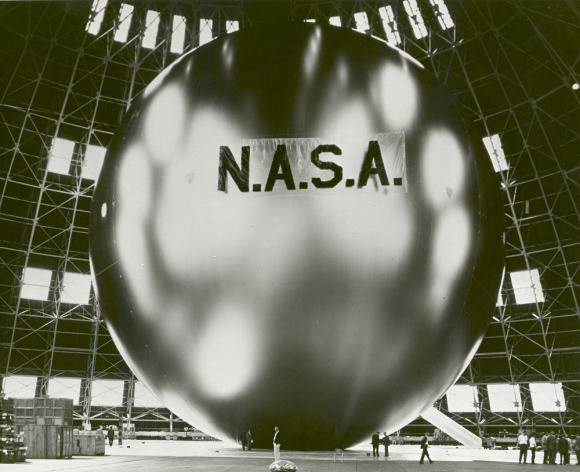
More recently, China has made a vague claim that it wants to put an orbital mirror “brighter than the Moon” over its cities to abolish night, but has failed to release much by way of specifics. Our own back-of-the-envelope calculations suggest you’d need place a 99% reflector about 1-2 kilometers in diameter in geostationary orbit to approach the brightness of a Full Moon. With an albedo of 10-12% (about that of worn asphalt), the Moon is actually a terrible reflector, but even though it’s ten times farther away than GEO orbit, it’s much much larger, at just under 3,500 kilometers across.
Semi-successful reflector satellites in recent years have been much less ambitious. Progress M-15 deployed the Znamya-2 demonstrator, though it was only briefly spied by observers watching from the high Arctic prior to reentry.
The Iridium era ushered it the age of predictable flaring satellites, a happy though unintended side benefit of the communications constellation fielded by Motorola and now run by Iridium Corporate. These satellites are now rapidly getting phased out, and de-orbited in favor of the newer (non-flaring) series of Iridium satellites.
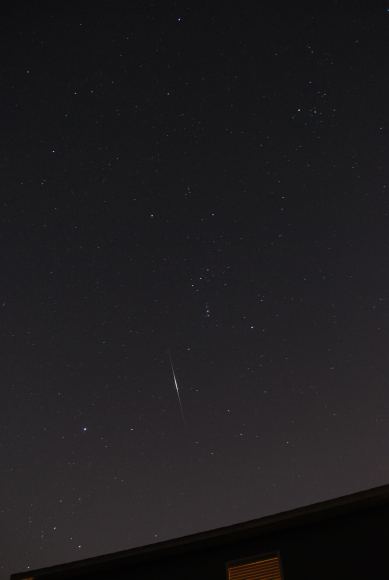
Some satellites, such as NanoSail-D2 and InflateSail are testing solar sail and controlled reentry technologies and also tend to flare in dramatic fashion. If the Planetary Society’s Lightsail-2 mission makes its way into orbit next year aboard a Falcon Heavy rocket as a secondary payload, it could shine at a brilliant magnitude -4 once unfurled.
Other attempts at making a deliberate space reflector, such as Humanity Star and Mayak have proved to be underwhelming. We caught sight of Humanity Star as a flashing +1st magnitude ‘star’ at best, and Mayak eluded most observers all together.
Public outreach, or menace to the night sky? Orbital Reflector bills itself simply as art, a reflection of humanity and our aspirations as we look space-ward. Trevor Paglen states that “Orbital Reflector is a work of aerospace engineering for engineering’s sake,” on the company’s website, and goes on to state that “When we look up into the starry night sky, we tend to see reflections of ourselves.” Satellite tracker Marco Langbroek also notes that “The question raised by Trevor is pertinent: Space is a public space. At the same time, it is not public at all, but strongly the domain and playground of nation states, and notably of the military of those nation states.”
While many decry this as a stunt at best, or another intrusion on dark skies at worst, we feel that anything that gets folks out looking at the night sky is a good thing, and ‘fizzle sats’ such as Mayak and Humanity Star show us that lovers of dark skies have little to fear from these efforts just yet.
Prospects for viewing: What can we expect from Orbital Reflector? Well, it’s entering a sun synchronous orbit along with the other Spaceflight SSO-A satellites, in a path inclined 97.6 degrees to the equator in a Low Earth Orbit, 575 kilometers in altitude. This means it will be in a highly inclined, retrograde orbit moving against the Earth’s rotation from east-to-west, instead of the standard west-to-east. Vandenberg typically launches satellites in this direction, as they head out over the Pacific to the west of California after launch, rather than over populated areas. Sun synchronous orbits are favored by Earth-observing (and spy satellites) placed in low-Earth orbit, as they make several successive passes over target regions with the same sun-angle, handy for image interpretation.
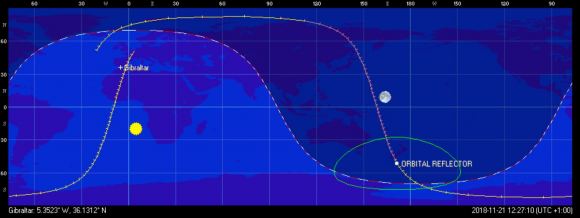
This does, however, present some difficulties with spotting Orbital Reflector shortly after launch and deployment, as it’ll only be visible initially from high southern and northern latitudes. Dr. Marco Langbroek also notes that Orbital Reflector will produce specular flares like the first generation of Iridium satellites, meaning that flashes into the negative magnitudes will only briefly be visible along narrow paths across the Earth’s surface at dawn or dusk. Langbroek also notes that if Orbital Reflector survives into the Spring of 2019 (it’s only meant to last for three months) we could start to see it at lower latitudes.
Turns out, it’s tough to deliberately make a good reflector satellite these days… I think it’s interesting that the most dependable and brilliant of the flaring satellites—the first generation of Iridiums—were actually never intended to specifically do so, but in the process, became great public outreach tools for astronomy. Unfortunately, the newer generation of Iridiums do not flare in the same fashion.
We’ll be using our tried and true method to stalk Orbital Reflector: first, note a good time when its passing near a bright star on Heavens-Above near dawn or dusk… then sit back, aim at the target star with binoculars at the assigned time for your location, and watch as Orbital Reflector (hopefully) drifts through the field of view.
Good luck… we’ll be updating this post with a firm launch time once it’s announced, and add in the assigned US Space-Track ID for Orbital Reflector once it’s published and sorted out from the other payloads.
Read all about chasing satellites and satellite flares in our new book: The Universe Today Ultimate Guide to Viewing the Cosmos: Everything You Need to Know to Become an Amateur Astronomer on sale now.

It will truly be a pathetic day in World history when/if advertising in space is implemented.
As to China’s government wanting to cancel out darkness above some of their cities: Imagine how unpleasant it would be to live in a city that never has the darkness of night. No thanks.